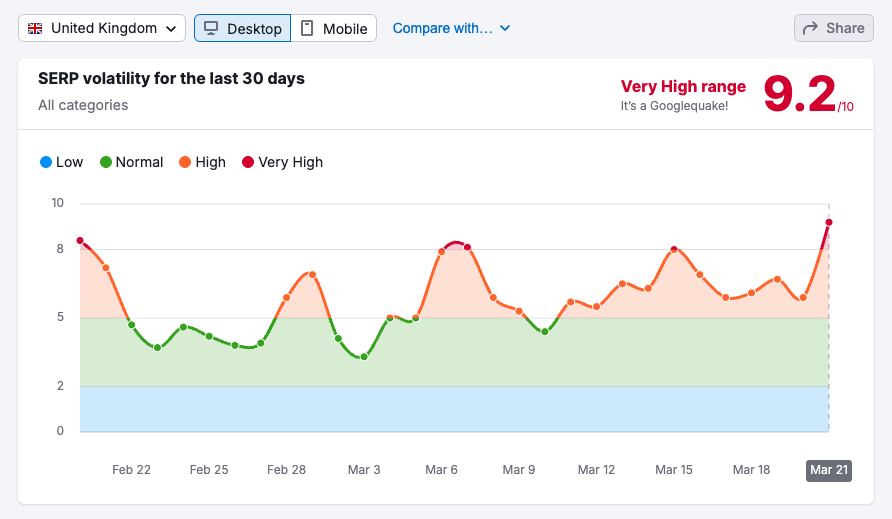On the 13th of March, Google began rolling out its latest core algorithm update, the March 2025 Core Update.
This is the first Google update of 2025, following the most recent December 2024 Spam Update.
Like previous updates, this one focuses on improving search quality by prioritising helpful, relevant content and reducing the visibility of low-quality pages. If your rankings have shifted recently, this update could be the reason.
During the rollout, many websites saw significant ranking volatility. If your traffic has dropped or your rankings have changed, keep reading to understand what’s happening and what you can do about it.
What does the March 2025 Core Update focus on?
Google hasn’t provided a full breakdown of the changes, but the update is aimed at refining search results by:
- Improving the ranking of high-quality content
- Reducing low-value, unhelpful, or outdated content
- Strengthening its AI-powered ranking systems
Google’s core updates typically refine how its ranking algorithms assess content. While no specific sites are targeted, those that don’t align with Google’s evolving standards may see declines.
What’s changed in the March 2025 Core Update?
The March 2025 Core Update follows several months of algorithm adjustments surrounding content quality and AI content relevance.
As the update began rolling out on the 13th March, here’s what Google said: “Today we released the March 2025 core update to Google Search. This is a regular update designed to better surface relevant, satisfying content for searchers from all types of sites. We also continue our work to surface more content from creators through a series of improvements throughout this year. Some have already happened; additional ones will come later.”
While Google has not confirmed every detail, many industry experts have noted:
- Increased scrutiny on AI-generated content that lacks depth
- Stricter evaluation of content authority and expertise
- More emphasis on content originality and user experience
If your website relies on outdated SEO tactics, thin content, or AI-generated content with minimal value, you’ll probably see some traffic and ranking drops.
As you can see from this screenshot from Semrush’s Sensor tool, there’s a huge level of ranking volatility across all industries at the moment, with the last 30 days scoring an average of 9.2/10!
This is expected to continue throughout the update rollout, which will likely last another couple of weeks.
 Very high SERP volatility as a result of Google’s March 2025 Core Update
Very high SERP volatility as a result of Google’s March 2025 Core UpdateHow to recover if you’ve been impacted by the March 2025 Core Update
Review Google’s search quality guidelines
Google’s search quality guidelines lay out what they want to see and how they decide which websites should rank well. These guidelines focus on whether your content is useful, trustworthy, and relevant to users.
If your site doesn’t meet these expectations, your rankings may drop. For example, thin pages with little value or misleading information often get pushed down.
Go through Google’s content guidelines carefully and ask yourself: does my content answer real user questions? Is it original? Does it reflect expertise in the subject?
Following these guidelines gives your site a stronger chance of recovering after a Google update.
Focus on high-quality, useful content
Low-value content is one of the most common reasons for a rankings drop after a core update.
If your pages are vague, outdated or written solely just to rank for certain keywords, you’ll struggle to compete. Google wants to show users content that’s genuinely useful.
Add detail, answer real questions, and back up claims with credible sources. For example, if you run a legal blog, include case examples or expert insights, not just generic summaries.
Ask yourself: if I were searching for this topic, would I find this page helpful? If the answer is no, update and improve it!
Improve user experience
Google wants users to have a smooth and simple experience when visiting websites.
If your site is slow, hard to read on mobile, or difficult to navigate, people will leave quickly, and your rankings will suffer.
Check your loading times, especially on mobile. Make sure key pages are easy to find, buttons are clear, and the design doesn’t feel cluttered.
Even small fixes, like reducing image sizes or improving menu structure, can make a big difference to usability and search visibility.
Monitor your site performance
If you’ve been hit by the March 2025 Core Update, the first step is understanding what changed.
Use Google Search Console to see which pages lost traffic, which keywords dropped, and whether Google has flagged any technical issues.
Look for specific patterns. Did traffic fall across the whole site or just certain sections? Are there crawl errors or broken links?
Track changes over time. Don’t just focus on rankings; monitor impressions, click-through rates, and engagement. These metrics tell you if users are finding your content helpful.
Be patient
Core updates don’t have quick fixes. You can improve your site, but it might take weeks or even months to see results.
Avoid making too many changes at once. Focus on quality, user experience, and trust. Stick to what you know works: useful content, technical accuracy, and a good experience for users.
If you rush, you might do more harm than good. Recovery takes time, but consistent effort pays off. Keep improving and stay focused on what your audience actually wants.
Need help from our SEO Specialists?
If the March 2025 Core Update has impacted your website, our SEO specialists can help!
We’ll run a full audit to assess your website’s performance and content quality and provide actionable tips and steps to help you follow Google’s search engine guidelines and improve your organic rankings.
Call us on 01329 565001 or fill out our contact form to speak to a specialist.